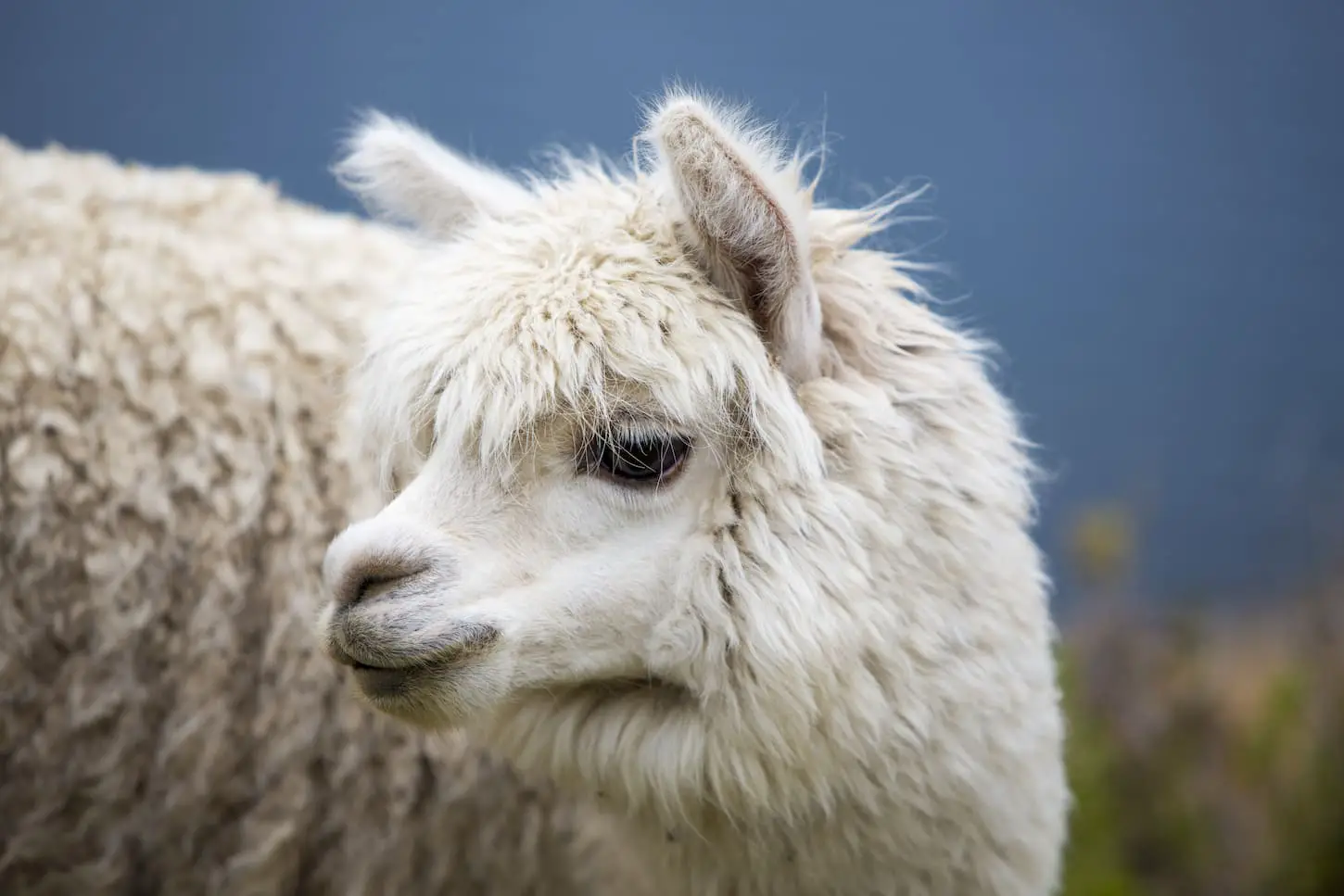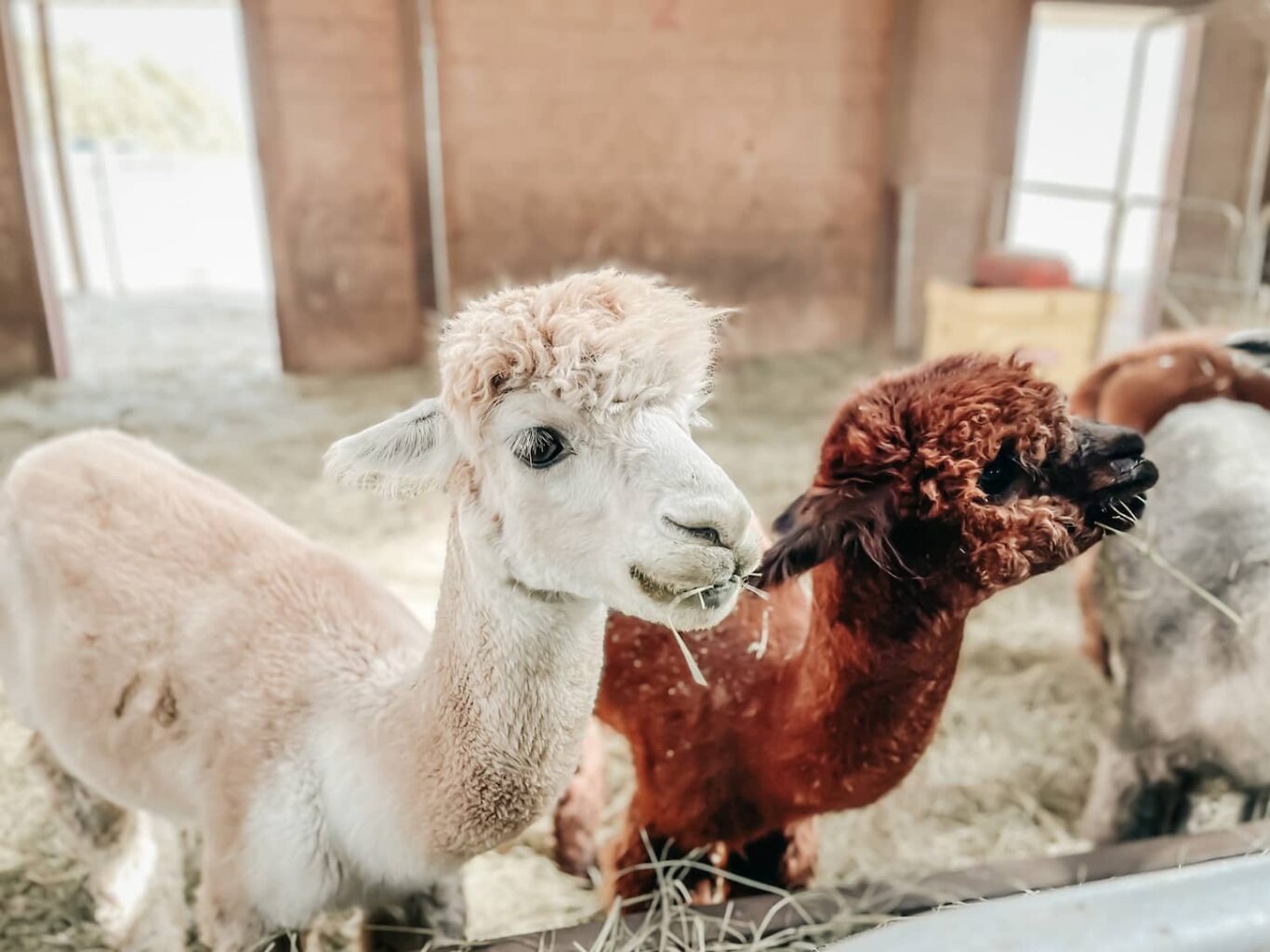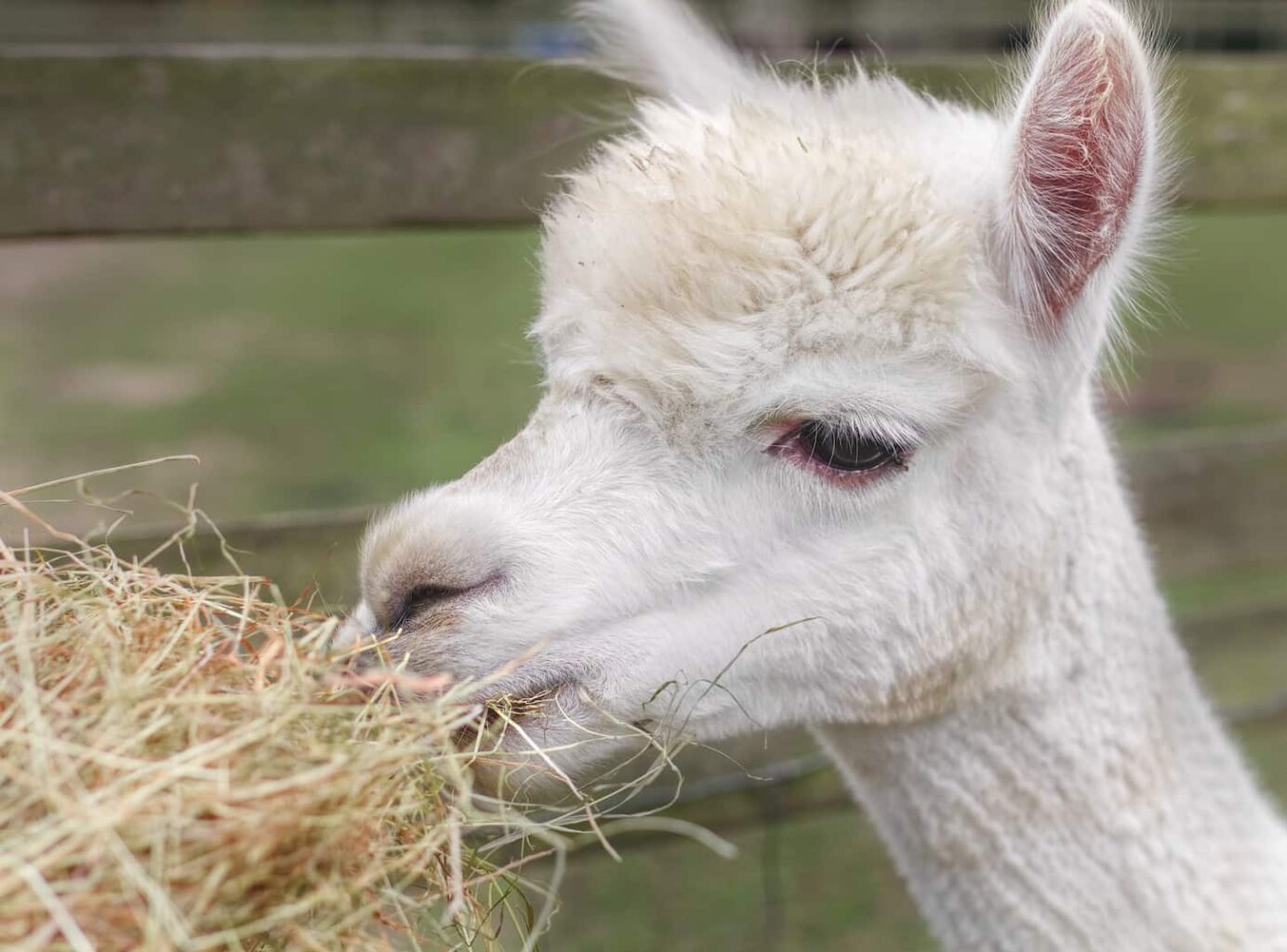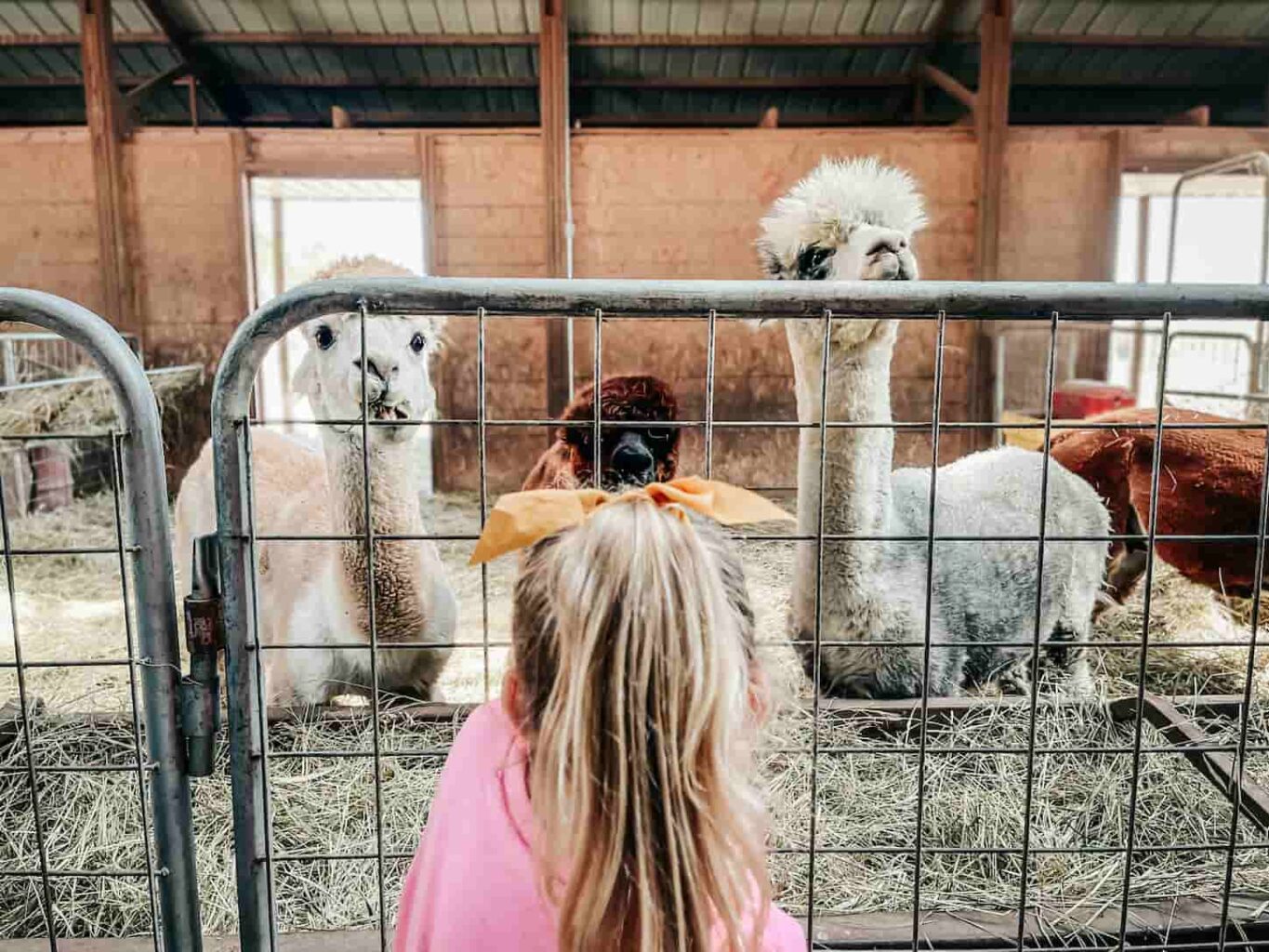While llama fiber isn’t quite at the same level as alpacas, it can still be quite beautiful. And llamas are an interestingly increasingly popular pet of choice, especially for backyard homesteaders. So can llamas be good pets for everyone?
Llamas can be great pets due to their calm, social, and easily trained nature, though they are livestock who do the best living outdoors in a dedicated shelter and area of their own. Llamas also need a herd and adopting a human family as their herd can get dangerous for humans.
Llamas are not as easy to just adopt or buy to own as a pet. They’re certainly not at most local animal shelters to adopt! And before you add a llama to your backyard menagerie, there are many things to consider, such as providing it space and veterinary care. They should also be kept with another fellow llama, which would require ample room wherever they’re kept.
If you’ve made it this far, you’re probably serious about wanting to own llamas. Keep reading on to know everything there is about having llamas as pets.

Llamas as Pets
Llamas can be pets, though they do best as pets kept outdoors due to their large size, need for a herd, and need for a large amount of space. Llamas also generally prefer to be outdoors, though in inclement weather they do seek shelter.
There’s no doubt that the fluffy, cuddly-looking animal is adorable to look at. But beyond its cute looks, are llamas considered good pets? Let’s unpack some of the frequently asked questions as to what llamas have to offer as being your pet.
Can you have a llama as a house pet?
It is possible to have a llama as an indoor house pet if the home has sufficient space for the animal, the rest of its herd, and space to accommodate the rest of its needs. However, due to llama’s size, most people don’t prefer to keep them inside human living space as it gets crowded quickly.
Having a llama as a pet sounds good and all but can you have one? Yes – you can if you grasp an understanding of their particular needs.
All they really need is space. Unlike cats and dogs, it can be problematic for llamas to physically live inside your home. Instead, llamas would enjoy living in a shelter outside near their roaming and grazing area. A spacious backyard would be enough to have them living happily under your care.
Llamas are known to be protective of their family members, which includes their owners if they show them love, and respect, and you can set proper boundaries between humans and herds.
If you have other pets, llamas will also generally play along with them. Compared to alpacas, llamas are more intelligent and social enough to spend time with people.
Is having a pet llama a good idea?
A pet llama with its herd, kept in an appropriate shelter outdoors, can be a great idea. Llamas can guard other livestock against smaller predators while offering companionship to the human family and its herd.
One of the advantages of having pets (including llamas) is that they offer you companionship, as well as other benefits.
Similar to a guard dog, llamas can also protect the home. For instance, llamas can protect your other livestock, like sheep, from lurking predators. They can fend off a coyote and can even sound an alarm call to let their owner know. However, they may have trouble defending multiple predators at a time, such as a pack of dogs.
If you prefer having pets that don’t require much energy from you, like cats, llamas could be a good match for you.
Llamas have a cool and calming quality. These traits not only make them good pets but also great therapy animals. It would be great to spend time with the elderly, children with special needs, or just about anyone. Their friendly nature makes them enjoyable to hang out with.
Do llamas make good house pets?
Llamas are rarely kept indoors due to their size, need for a herd, and strong desire to be outdoors grazing. Llamas prefer to be outside, but they will seek shelter during a storm or bad weather. Keeping a cozy barn or shelter for the llama tends to be the better route.
Llamas are considered companions more than anything else. Initially, their sole purpose may be to provide you with fiber.
But you’ll quickly realize they’re not just good at guarding or offering fiber – they make good pets. They just make better pets who live outdoors, for the most part. But if you can build them a cozy barn or shelter? Then you can always go visit your pet in their space. And they’ll have their herd to keep them company when you’re off doing other chores or whatever else.
For those that have experience in owning them, llamas are well-mannered and low maintenance.
How long do llamas live as house pets?
Llamas generally live between 15-30 years. Well-cared-for llamas can live longer, fuller lives than wild llamas.
Llamas who get appropriate care will almost always live longer than their wild cousins. However, there’s always a risk of sickness or predators getting into the homestead no matter how careful you are. So don’t think I’m promising your animal will live 30 years – because I can’t guarantee that.
One other note on a llama’s lifespan. I’ve read that llamas who are regularly used to carrying heavy loads do tend to have a shorter lifespan than llamas who carry loads less often (or that aren’t too heavy). So keep that in mind.
Llamas are actually considered companions more than anything else. Initially, their sole purpose may be to provide you with fiber. But you’ll quickly realize they’re not just good at guarding or offering fiber – they make good pets. For those that have experience in owning them, llamas are well-mannered and low-maintenance.

Caring for Llamas
Llamas require grazing space, a herd, water, shelter, regular foot (toenail) and tooth care, grooming, veterinary care as needed, and general care. With proper care, a llama herd can be a great addition to any backyard homestead or farm.
Just like every other pet, llamas need to be taken care of in order to keep them happy and healthy. Even though they’re considered livestock, they still require attention and care the same way as your more traditional household pets.
Are llamas a high-maintenance pet?
Llamas are not high-maintenance pets, despite their large size. Being mild-mannered, clean, and easy to maintain makes them a popular choice for a pet. They don’t need much maintenance beyond basic care.
In terms of diet, llamas are not picky eaters and don’t need exceptional food or exotic vegetables to survive. They’re content with feeding on hay and grass.
The cost of maintenance of llamas is minimal in comparison to other animals. If there’s one costly thing, it would be if you need to buy extra space for them. Otherwise, they’re perfectly happy with grazing fields.
Are llamas easy to care for?
Llamas are generally easy to care for, but they will need to be groomed every so often. Here are the key things you’ll need to remember when caring for your llamas:
- Feet. Llamas will need to have an occasional toenail trim. Depending on the ground they tread on, they may need to be trimmed more often. How often you do it also depends on the llama. You can use nail clippers that are for sheep and goats, although there are also specific clippers for llamas.
- Shearing. Some llamas don’t actually need to be shorn, but doing so can be good for their health. Long woolen llamas would need to be shorn every one to two years. Ones with short wool don’t need to be shorn, but they should be brushed to keep their coats clean. Brushing also removes loose, shedding fiber.
- Teeth. Male llamas grow fighting teeth when they’re around two or three years of age. Some owners leave them, but it’s often safer to have them removed. They’re extremely sharp and can hurt other male llamas if they’re in the same vicinity. Make sure to seek a vet or experienced breeder to have them removed instead of doing it yourself.
You’ll also want to check your llamas’ ears regularly for ticks or other annoying bugs. Grazing animals can tend to pick those up by accident. But doing a quick peek daily at ears and general overall health is a great way to care for your llamas – and it’s super quick to do.

How to care for a pet llama
Before having your llamas move in, there are a few things that you’ll need to have in place:
- The right property. They need room to graze and walk and run around. Llamas are up to 50 inches high at the withers and up to 72 inches tall at the poll. In terms of weight, they can reach around 300 pounds (they can be anywhere from 250 to 450 pounds). They’re not exactly small animals, so you should make sure that you have enough room to accommodate them.
- Shelter. During extreme weather, it’s important that your llama has a place to feel safe. In cold climates, a barn or windproof housing is needed. When it’s hot, ensure your llama gets air flow by having open sides in the shelter. A three-sided shelter is a popular housing option that covers your year-round llama shelter needs.
- Fencing. If you have an open field for your llama to move around in, make sure to install proper fencing. This ensures that your llamas stay inside. You may also need to have more fencing if you have more than llamas to keep them separate at times. Not only do fences keep llamas in, but they also keep predators out of your herd.
- Other llamas. As they’re very social herd animals, you should consider getting more than one. Your llama really needs companions to make them comfortable in the environment. Any herd animal needs at least 1-2 other animals in their herd, ideally of their own species.
- Have a consistent flow of llama supplies. These animals must maintain a very specific diet in order to be healthy. Grooming practices are also key, such as toenail trimming and wool shearing, so you’ll need to make sure you have the tools at hand.
- A trusty veterinarian. There comes a point in a llama’s life where they’ll need to be vaccinated, de-wormed, and go through other health checks. Llamas have a specific schedule and are more susceptible to certain parasites, requiring regular checks. This makes it sound as if llamas are prone to being ill, but they are generally hardy animals and will do fine when help and care is sought. Having a veterinarian who knows how to treat llamas nearby can be the life-or-death factor for your pet.
Caring for llamas really isn’t crazy difficult. But it does require that you know what you’re doing and to have a good veterinarian. They’ll be able to talk you through all the care schedules. They should be able to help you learn what care you can safely do at home versus when to call them to step in and help.
Llama Behavior
If you haven’t spent much time with llamas before owning one, it would be worthwhile to study a little about them. If you haven’t spent much time with llamas before owning one, it would be worthwhile to study a little about them. Even though they are generally pleased when interacting with people, it’s still important to be familiar with their behavior
Do llamas like to be petted?
Llamas who are appropriately socialized with humans will tolerate or enjoy being petted. Always ask the llama’s owner for permission before petting them. Be aware that not all llamas are socialized the same as humans.
Due to their curious nature, they are generally happy to approach people and will tolerate being petted. Since llamas have been domesticated for many centuries, they don’t mind being petted or even cuddled. Their friendly nature makes them more open to receiving love from their owners.
However, this also depends on how the llama was raised, as llamas that are over-socialized with humans in their infancy can be difficult to handle when they’re older. This is because they will treat humans just like how they treat one of them: a lot of spitting, kicking, and neck wrestling.
And due to their large size (up to 450 pounds), an over-socialized and aggressive llama gets dangerous to people quickly.
Do llamas like to cuddle?
Some llamas enjoy cuddling their favorite people by rubbing their heads and necks on them. These llamas may even run towards their favorite people in order to be petted or cuddled.
Llamas are known to be affectionate animals. They can show their love for you by running toward you and rubbing their head on you in a loving way. They’re compassionate animals and can show emotional responses in various ways. They can even smile!

Are llamas friendly?
Llamas are friendly animals to most people and non-aggressors. Llamas will only spit, kick, charge, or attack threatening predators or unwanted attention.
You may think back to videos of llamas spitting at people, but they only do this to warn aggressors away. When provoked or feel threatened, they will do it with little to no warning. They also do this to each other to keep competitors away from food. Female llamas also do this to tell a male that she’s not interested.
When you show compassion and love to your llamas, there’s pretty much zero chance they would want to spit at you.
While some llamas are more short-tempered than others (and can spit for no reason), most will keep their spit in their mouths. All in all, llamas have a friendly disposition despite their spitting abilities!
What is the friendliest breed of a llama?
All llamas are considered friendly, as there is only one breed of llama. Llamas, and their similarly domesticated cousins the alpaca, are the friendlier part of the South American camelid family.
Here’s an interesting fact: there’s only one type of llama! Llamas (scientifically known as “lama glama”) belong to a group of animals known as the South American camelids. Alpacas are included in this family, as well as similar-looking animals including guanacos and vicuñas. Llamas and alpacas are the only animals from this group that are domesticated, making them (and the alpacas) the friendliest.
Do pet llamas love their owners?
Llamas kept as pets or as livestock can love their owners, depending on how they’re treated, cared for, and other factors. Food and time are two important factors in gaining a llama’s love.
Just like with most animals, the more time you spend with them, the more they will love you. Gaining their trust won’t happen straight away, but consistently hanging out with them will make them feel more comfortable around you.
Do llamas get along with other animals?
Llamas are known for getting along with many other animals, especially other herd animals. Llamas may get along well with dogs, too.
Apart from being able to fiercely protect sheep and other livestock from predators, llamas can also get along with dogs. Similar to dogs, llamas are domesticated animals that like to spend time with their owners. Llamas can enjoy a dog’s presence and it’s known for these animals to be able to bond well.
This of course assumes that your dog is a well-trained animal. No herd animal (llamas included) will tolerate a dog that’s gone feral or wild with a pack of other neighborhood dogs.
Which is a better pet: a llama or an alpaca?
Pet llamas and alpacas are different sizes; a pet alpaca could be a better indoor pet than a llama, while both do well if kept outdoors with a herd.
While they often get confused for one another, llamas and alpacas are completely different looking (but they’re both modified or pseudo ruminants). Apart from their looks, they also behave differently.
- For instance, llamas are used to interacting with humans as they’ve helped with hauling goods for many years.
- On the other hand, alpacas have been described as more “aloof” and have a more unpredictable temperament. Alpacas also prefer to be on their own and try to avoid people more. While alpacas seem cuddlier, llamas may make better pets for most homesteaders – especially if you’re wanting to use them to carry any goods.
That being said, there are known instances of alpacas being indoor pets (and some even going viral on Instagram). You can read more about cute alpacas being indoor pets in my article right here.
As far as which one is better for you? It’s going to depend on your situation, needs, and goals.
- If you’re wanting a smaller animal or more fiber, then you’ll likely want an alpaca.
- Or if you’re wanting a larger animal to guard livestock or a good pack animal, then you’ll likely want a llama.
The great thing about these animals is how kind, gentle, and amazing they are. You really can’t go wrong with either one. So go ahead and focus on your goals and needs, because you can do well with both.
Final Thoughts on Llamas as Pets
Due to centuries of being domesticated, llamas make for good human companionship. They’re sociable, friendly, and easy to care for. Their calming nature relates well to a range of demographics, including children and the elderly.
Personally, with our half-acre backyard homestead, we’d be more likely to get an alpaca than a llama, but that’s mostly because our pasture is only 0.1 acres (of the 0.5 acres). And we could more easily fit two alpacas happily in that space than two llamas.
Plus, we’ve got small children who fear large animals. So, they’d likely do better with alpacas than llamas. But as they grow? We could probably change out the alpacas for some llamas. Because how cool would that be to go on a hike with the llamas? I think it would be pretty cool! We’d just need to watch for mountain lions here in Utah.
In any case, owning llamas is not as simple as having a small tabby cat move in. But with the right planning and consideration of shelter, it will be much easier. Given the significant commitment of
time, space, and potential finances required to care for them, llamas may not be for everyone. But the efforts should be well worth it!
Now that you know more about keeping llamas as pets, make sure you read this article about camelids (alpacas and llamas) and their predators. That way, you’ll be totally prepared to keep your animals safe from harm.
Resources
Learning from your own experience is essential, but learning from others is also intelligent. These are the sources used in this article and our research to be more informed as homesteaders.
- “Llamas and Alpacas. A Guide to Management.” Gina Bromage, https://books.google.com.au/books?hl=en&lr=&id=J5R8AwAAQBAJ&oi=fnd&pg=PT4&dq=Do+llamas+make+good+pets%3F&ots=PGueopBVaT&sig=dSSgKb4_-ApodAoDA_HXnPbbGKU#v=onepage&q&f=false.
- “Llama Care – Medical and Maintenance.” Animal Info Publications, https://www.animalinfo.com.au/fact_sheets/view/12/11/112/total:1
